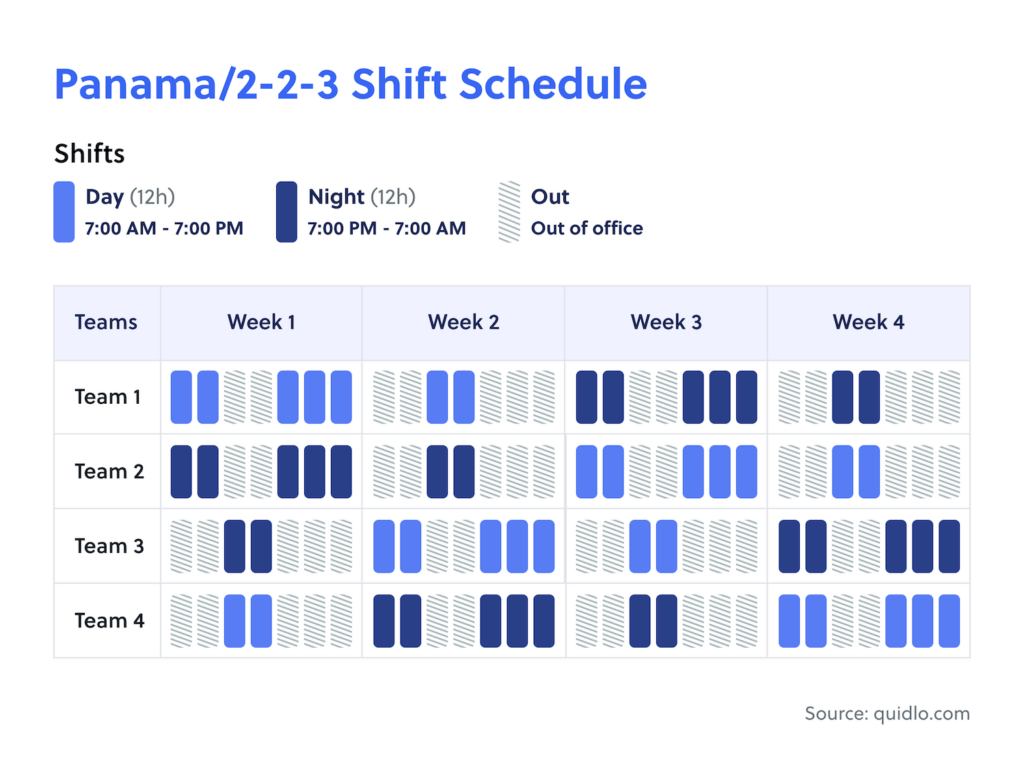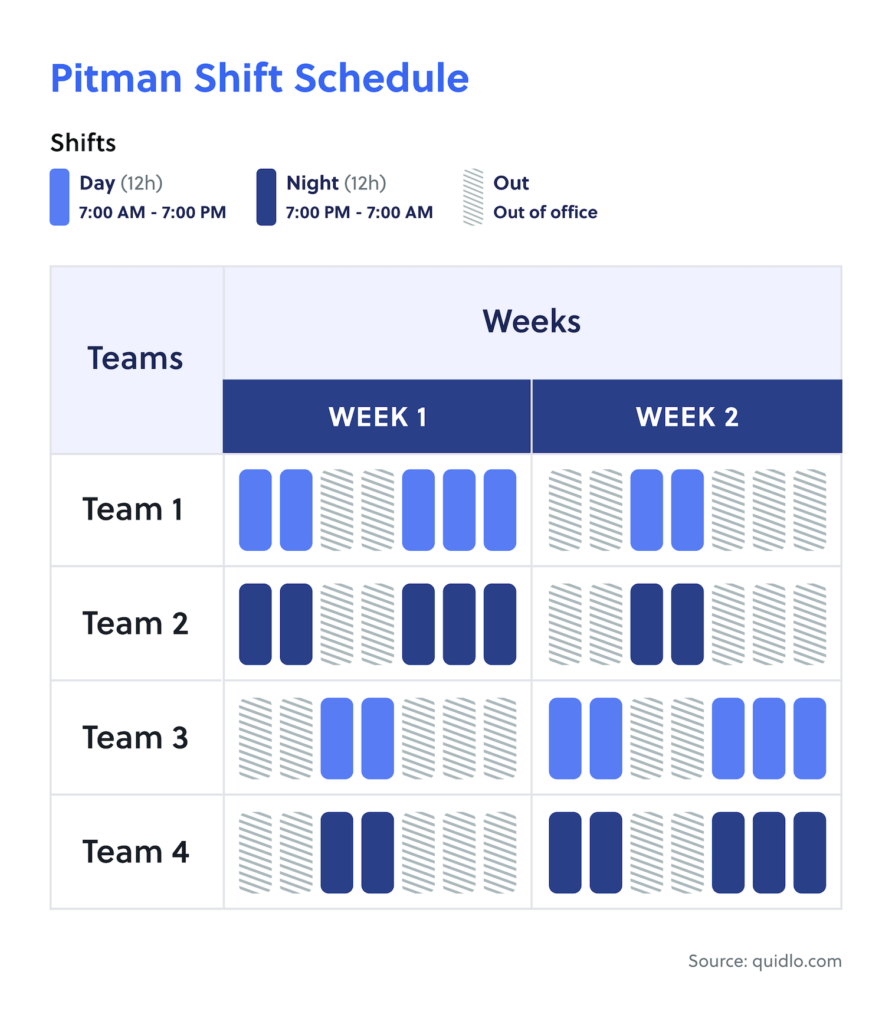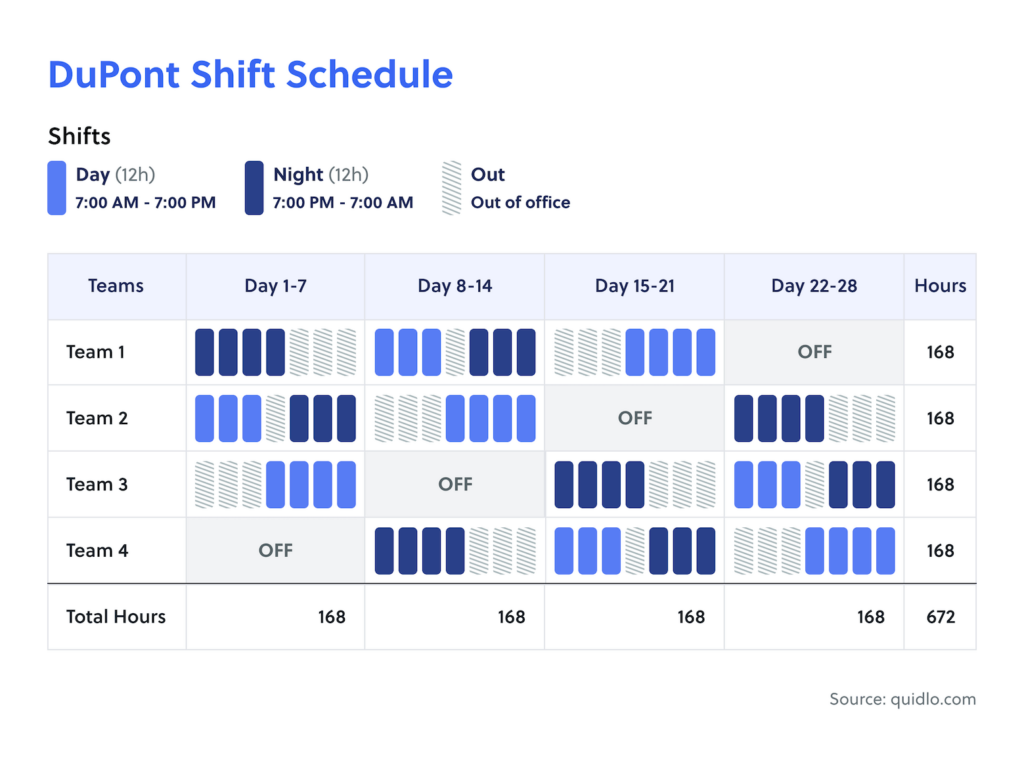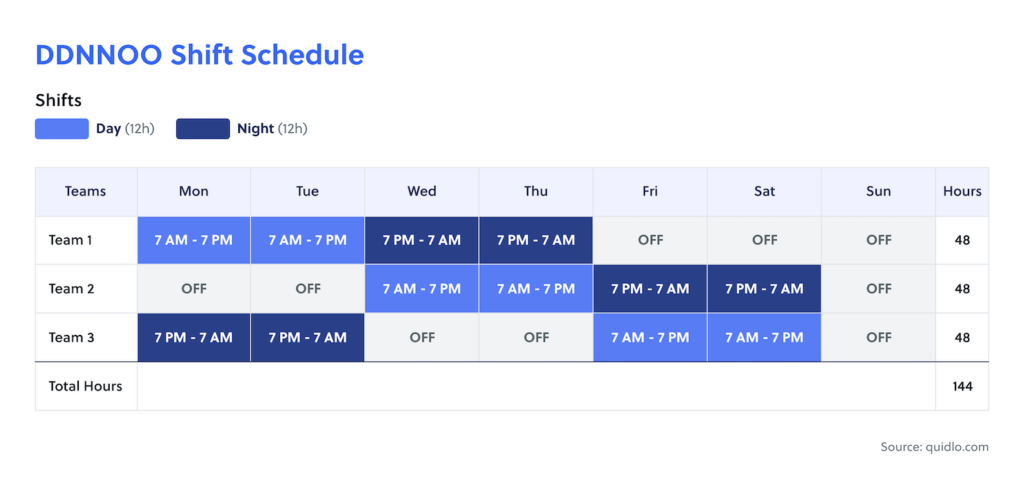As a team or branch manager, developing a shift schedule that works is your job. However, it isn’t easy without a proper approach or plan. As a result, it’s known that 1 in 5 U.S. employers give their employees less than a week’s notice about their shifts – this isn’t acceptable.
If you manage a 24/7 team, the difficulty is increased further. However, after all this procrastination, there’s a solution. In this circumstance, many choose a 2-2-3 work schedule. Implementing this type of plan can enable you to create a timetable that supports a smooth, positive work-life balance.
Because it’s such a robust work schedule for industries that work 24/7, we’ll dive deeper into the topic. To learn more about the plan and how to use it effectively, see the below:
Table of Contents
How Does a 2-2-3 Schedule Work?
The 2-2-3 work schedule is a 28-day rotating cycle where employees work 12-hour shifts. Because of the workdays’ length, these consist of day and night shifts to accommodate the whole 24-hour period.
This plan usually utilizes a team of 4, working 2 days, resting 2 days, and then working the following 3 days. Throughout the month, this is repeated weekly. However, there are two cycles. The first week remains the same; the next begins with 2 rest days, 2 workdays, and then 3 rest days. Once the second week is finished, it reverts back to the first cycle.
When you follow this plan, it’ll provide 14 12-hour shifts, with each week cycle being fully covered 24/7. Here’s how it looks on a real timetable.
Example of a 2-2-3 work schedule
We all know the difficulty of 12-hour shifts. It’s even been proven that it presents work-induced fatigue. However, the above 2-2-3 work schedule provides staff with greater flexibility and consistency despite working long shifts. As an impact of this, it boosts employee satisfaction.
2-2-3 Work Schedule Variations
After reading the above, you should understand the 2-2-3 approach and its capability to plan a 24/7 shift timetable successfully. However, one plan doesn’t always suit all. Because of this, there are multiple variations of the 2-2-3 schedule, including the following:
Panama Shift Schedule
The Panama schedule is the standard 2-2-3 plan mentioned above. Therefore, it consists of four teams and 12-hour shifts.
When implementing this into an organization, it follows a slow rotation system. Team members under this schedule start the first week by working 2 days, resting 2 days, and then working the following 3 days. The second week begins with 2 rest days, 2 workdays, and then 3 rest days. Because of its two-week pattern, many managers use this in a 28-day cycle.

The above 2-2-3 work schedule is a go-to option for many who want to organize 24/7 shifts. Whether it’s emergency services or manufacturing, both industries can benefit from this.
Pitman Shift Schedule
Unlike the standard Panama plan, the Pitman shift schedule uses a different shift pattern. Though it still uses 12-hour shifts, the actual working days change. As a result, many refer to the Pitman Shift Schedule as a 2-3-2 pattern instead of a 2-2-3.
With a 2-3-2 pattern, the first-week employees will have two shifts, two off days, and three more shifts. The following week, this changes to two off days, two days of work, and three days off.

This 14-day rotation is excellent when organizing night shifts. As known, night shifts affect your body’s circadian rhythms. Therefore, planning them correctly is necessary. By utilizing this plan effectively, deploying this version of a 2-2-3 work schedule can help reduce the adverse health effects of working during the night.
DuPont Schedule
Unlike the other rotating shift schedules above, the DuPont option is slightly different. Instead of a rotation, the DuPont schedule uses “stages.”

It follows a similar method to the above options, though. With four teams, four weeks, and 12-hour shifts, the stages look like the below:
- Stage 1 – Work four-night shifts followed by three days off
- Stage 2 – Work three consecutive day shifts, one day off, then three consecutive night shifts
- Stage 3 – Have four days free and then four-day shifts
- Stage 4 – Have an entire week free
With the above, you want to assign each team a stage. As each week progresses, each team will move on to the next stage and repeat the process.
For most, this works excellently. Though you work a lot during stages 1-3, stage 4 is undoubtedly rewarding and a huge perk.
DDNNOO Shift Schedule
One of the most basic variations of the 2-2-3 work schedule is the DDNNOO option. To understand this further:
- D = Day
- N = Night
- O = Off/free
The only problem with the DDNNOO is that it only accounts for a six-day cycle. A team of three will rotate between two days of work, two nights, and two free days. Therefore, it only accounts for six out of the seven days of the week.

Though this is easy to implement, changing this into a 24/7 shift schedule can be difficult. To fill in the other 24 hours, you need another team or a group of individuals wanting to work an extra day (typically the quieter days).
Advantages of a 2-2-3 Work Schedule
After reading the above, you should understand the 2-2-3 work schedule (Panama scheduling). To discover the pros and cons centered around this planning method, see below:
- There will only be 180 days of work for employees per year
- Useful for administrative, military, medical, and other training tasks
- Employees can have 3-day weekends every alternating week
Disadvantages of a 2-2-3 Work Schedule
However, like anything in life, there are downsides to this work schedule. Although these are limited, it does consist of the following:
- Employees working constant 12-hour shifts
- Negative health effects can occur from two or more 12-hour shifts
- Sleeping cycle may get affected if employees cannot adapt (resulting in shift work sleep disorder)
Above are the advantages and disadvantages of a 2-2-3 schedule. As seen, both have great points. However, it would help if you had the right strategy, employees, and industry to gain the most benefits.
Who is a 2-2-3 Work Schedule for?
Typically, those choosing a 2-2-3 shift plan manage industries with 24-hour coverage. Whether this is 5-days a week at 24 hours or seven days, the 2-2-3 can get used for either circumstance.
Because of this, limited number of businesses would use such a work schedule. However, to gain a visualization of a few, here are some options:
- Call centers
- Manufacturers
- Emergency services
Each industry above may or may not work in a 24/7 shift pattern. For instance, a call center doesn’t need to work 24 hours. However, larger, globalized brands might work 24 hours daily, depending on their consumers.
Manufacturing or emergency services typically need to perform services 24/7. Therefore, a 2-2-3 would work perfectly in each environment to ensure you’ve got a fair amount of workers each shift while considering their work-life balance.
How Popular is a 2-2-3 Work Schedule?
Although most companies don’t publicly announce their shift plans, we assume that most 24-hour or 24/7 businesses utilize this work schedule. The reason for this is simple;
- It considers a work-life balance
- It’s easy to implement with teams
- Making team or individual-related changes to the timetable is possible because of its natural structure
Because of these three reasons, we believe that many businesses that work around the clock use the 2-2-3. To see which large organizations use this style of work schedule, see the below examples:
Companies Using a 2-2-3 Work Schedule
There are many benefits to working a 2-2-3 shift plan for companies that work 24 hours during the week or 24/7. Because of this, we researched organizations that operate these types of hours to see who uses the 2-2-3 plan. Here’s what we found out:
Amazon
As expected, Amazon uses a variation of the 2-2-3 shift plan. Undoubtedly, this isn’t for all of Amazon’s operations. The one job we’re speaking about here is their warehouse.
Amazon is known for its fast, next-day deliveries. To achieve this, they need to work 24/7. Without infrastructure like this, keeping up with the order frequency would be tough.
According to Amazon Jobs, the organization has a split day and night shift during the week. These are segmented into day and night. During the day shift, employees begin between 6:00 a.m. and 8:00 a.m. and end between 5:00 p.m. and 6:00 p.m. local time. As for the night, these shifts are between 6:00 p.m. and 8:00 p.m. and end between 5:00 a.m. and 7:00 a.m. local time.
As seen, it looks like they split into around 12-hour shifts. To make this operational and ensure that they have enough employees and teams available during the day and night, they use a 2-2-3 work schedule variation.
7-Eleven
Another organization that utilizes a variation of this shift planning method is 7-Eleven. As they’re one of the largest gas stations in the States, most are open 24/7. The reason for this is to keep up with the demand of the locals and truckers passing by.
However, instead of two 12-hour shifts, 7-Eleven splits this into three. According to Indeed, these range from 7:00 a.m. to 3:00 p.m., 3:00 p.m. to 11:00 p.m., and 11:00 p.m. to 7:00 a.m. With a shift pattern like this, a 2-2-3 schedule is used to ensure all employees get a fair break in between shifts.
Emergency services
Lastly, most emergency services follow this type of work schedule. Whether it’s the police, a hospital, or perhaps roadside assistance, they’ll all follow a similar plan.
However, these will change depending on the department, location, and specialty. For instance, in hospitals, doctors may work a 12-hour split. However, nurses commonly follow a 2-2-3 variation that allows for three 8-hour shift splits (morning, evening, and night).
Tips for Implementing a 2-2-3 Work Schedule
Though 2-2-3 shifts are one of the most convenient schedules regarding flexibility, managing your team while adhering to it may be tricky. Therefore, here are some tips on how to implement it successfully:
- Always have advance notice of shift rosters
Emergencies are a part of the job. Contingency plans are the only way to preserve appropriate scheduling. However, employee participation is required. Every schedule should be distributed ahead of time so staff can plan accordingly. Leaders should talk to staff when making roster changes. In such cases, employee feedback and considering their viewpoints on timetable modifications are equally essential.
- Set times that are suitable for your employees
It’s vital that your staff are happy with the start time of their shifts. There is no correct advice in this circumstance because each team has distinct tastes. For example, if most of your staff get up early, you can start the shifts at 05:00. However, if many employees choose not to start so early, you may have to change the hour. Without question, the team must be familiar with the shift timings to be most effective.
- Ensure plenty of breaks are in the shift plan
Breaks are an important part of the 2-2-3 work schedule. When a worker is stressed, they’re unable to deliver great work. Ensuring much-needed breaks guarantees that the employee can unwind with occasional pauses. After a long labor time, the human brain’s attentional resources deplete. After all, the most common 2-2-3 patterns feature a 12-hour shift.
Employees require breaks when working a 12-hour day. Taking frequent breaks aids in the development of an employee’s productivity and efficiency. This is something you must implement. Even making these breaks a mandatory requirement is a good practice.
- Have proper light facilities
A well-lit office environment directly influences your employees’ attitude, productivity, and energy levels. Appropriate workstation lighting allows employees to remain alert, creative, passionate, and psychologically prepared to give their best.
Too little light can produce fatigue, while too much light might cause eye problems and migraines. However, combining all these factors and providing enough lighting is far more crucial for increasing productivity.
For the best results, it’s been studied that working under “blue-enriched” bulbs is the best. The most optimal ones are 17,000k and are known to increase performance by supporting alertness, vitality, and acuity.
- Assist new employees
Including the above, another way to implement the 2-2-3 work schedule is by onboarding new employees correctly. It may take time for new employees to adjust to the routine emotionally and physically. Their bodies might not be able to withstand the job schedule (yet). This might cause issues in both their professional and personal lives.
An inexperienced worker who performed a night shift the night before is more likely than an experienced worker to make an error the following day. The rotating schedule may also cause fatigue, insomnia, and other problems for your new staff. As a manager, it is crucial to look for any indications of exhaustion frequently.
You can help them become accustomed to the workload and unique shift schedules; a wise step is to enlist the assistance of more seasoned workers.
- Offer the right amenities and reduce the wrong ones
Additionally, you need to provide the right amenities and reduce the wrong ones. 12-hour shifts are difficult. After a while, it can cause fatigue. In this circumstance, most workers will take a coffee. However, this can disrupt their sleep-wake cycle and make them more tired.
Instead of offering them coffee continuously, think outside the box. Some 2-2-3 work schedule managers create a “napping area.”
One of the main issues your workers may have when working in shifts is sleep loss. You can request that your staff members take a 15 to 20-minute nap while working the night shift.
Your sleep will be of worse quality if you sleep in the morning; therefore, taking naps at night is preferable. Additionally, taking a sleep might serve as a restorative respite for them.
- Rotate shifts frequently
Your staff needs some time to get used to a new routine. The circadian rhythm of your employees could become adapted to the timetable if you don’t vary it regularly. Additionally, they could find it stressful to switch shifts later.
Make sure your staff doesn’t have time to acclimate to a timetable. To do this, assign a different shift every two to four weeks. Change schedules after two or three days since the quick adjustments will lessen the impact on their sleep cycle.
- Always communicate with employees
The last tip for the 2-2-3 work schedule is communication. You’ll have a better knowledge of the preferred schedule of your staff if you communicate with them often. Additionally, you may permit your staff members to be flexible with one another when it comes to scheduling and switching shifts.
For instance, if the majority of your employees prefer the 2-2-3 schedule, stick with it. However, if a few of them prefer the night shift, you can divide the shifts more easily by assigning them to more night shifts.
Additionally, it’s a good idea to speak with your staff and inquire about their challenges and experiences. You should assist them in overcoming obstacles and boosting production in this way.
Final words
After reading the above, you should have a comprehensive understanding of the 2-2-3 work schedule. Now you know this, it’s easier to determine whether this shift plan will work for your team.







